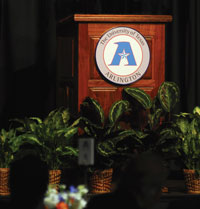| Inside a Washington insider | Teen alum amazes | The singing cancer crusader |
| Home Forethought President's Message Campus Buzz Feature Stories Re:Search The Score Alum News Yesteryear | ||
 Leaders address environment
Leaders address environment
Texans like to boast that everything is bigger in the Lone Star State. But that includes the production of greenhouse gas, according to the president-elect of Physicians for Social Responsibility.
“Texas accounts for one-fourth of the entire emission of carbon dioxide in the entire United States,” Dr. Catherine Thomasson said during a June conference at UT Arlington. “If Texas were a nation, it would be the seventh largest contributor to air pollution in the entire world.”
Mayors and health and environmental officers from cities as far away as El Paso and McAllen attended the Texas Cities for Climate Protection meeting called by Arlington Mayor Robert Cluck and co-sponsored by the School of Urban and Public Affairs. The afternoon featured addresses by Thomasson and Michelle Wyman, executive director of ICLEI - Local Governments for Sustainability USA. ICLEI is a global leader in driving local action to create a model for national change.
Wyman discussed some of the options available to improve air quality and reduce the pace of global warming, options that also provide economic benefits. She emphasized the power that local communities have to effect change, power she has seen in action across the United States.
Cluck, who is a physician, opened the conference by sharing his concerns about global warming and presenting documentation. Some people deny the seriousness of the warming pattern, but “if it’s just a global cycle and we take it seriously anyway, the worst thing that happens is that we improve air quality dramatically,” he said. “If it’s real, then we have the potential to eventually avert a true planetary catastrophe.”
Tom “Smitty” Smith, director of the Texas office of the nongovernmental organization Public Citizen; Dallas Mayor Laura Miller; and Environmental Protection Agency Regional Director Richard Greene also attended the conference. In addition to statistics on the melting polar ice caps, precipitation patterns, storm intensity and infectious disease, the participants discussed ways that global warming impacts air quality, especially ground-level ozone, which is linked to asthma and other respiratory illnesses.
Mayors at the meeting expressed concern about the 11 coal-burning power plants slated for construction in Southeast Texas, and several pledged to attempt to influence the utility companies to use modern processes to reduce air pollution.
Understanding Louis Kahn
Filmmaker Nathaniel Kahn, who directed the Academy Award-nominated film My Architect, likens making a documentary to a fishing trip.
“There is no script,” he said during a recent visit to campus. “And you really don’t know what you’re looking for until you find it. We shot about 200 hours of film for this two-hour movie.”
The School of Architecture hosted Kahn’s lecture, preceded by a screening of his first-person documentary about his father, architect Louis I. Kahn. The elder Kahn left a legacy of monumental buildings, including the Kimbell Art Museum in Fort Worth, the Salk Institute for Biological Studies in La Jolla, Calif., and the National Assembly Building in Bangladesh. He also left behind a wife and three children, only one of whom he fathered with his wife. Nathaniel and one of his sisters were fathered out of wedlock.
Nathaniel was 11 when his father died, and that loss, along with the public denial of his existence in The New York Times obituary, left him with a lingering question: Who was Louis Kahn?
More than 20 years later, he went on a journey for answers, traveling the world to see his father’s buildings and to interview people who knew him. The film analyzes Louis Kahn’s career and his life, describing the obstacles and influences that made him who he was. The cast of characters includes famous architects Philip Johnson and I.M. Pei, along with cab drivers and the three women who bore Kahn’s children.
Nathaniel and producer Susan Rose Behr edited as they went, so that, at the end of the journey, the film was nearly complete. Along the way, they never knew when they would make the big catch, like in the moving tribute to Kahn and his magnificent building in Bangladesh by a Bangladeshi architect.
“When we shot that scene, we both sensed immediately that we had found the ending for the film,” Behr said.
Nathaniel said he ended his journey with a better understanding of his complex and contradictory father. He also realized that creating a building and making a movie have a lot in common.
“Both are based on an idea, a structure, and it’s a slow building process,” he said. “You put stone on stone until you’re done.”
— Sue Stevens
| Archives
| Alumni Association |
Giving to UT Arlington | UT
Arlington Home Copyright © 2006 UT Arlington Magazine. All rights reserved. |
